
President Trump delivers on campaign promises by signing an executive order threatening to cut federal funding to sanctuary cities that refuse to cooperate with immigration authorities.
Key Takeaways
- President Trump’s executive order targets sanctuary jurisdictions that hinder federal immigration enforcement efforts
- The Justice Department will compile a list of non-compliant jurisdictions that could lose federal funding
- Attorney General Pam Bondi and DHS Secretary Kristi Noem are authorized to pursue legal actions against cities defying federal immigration laws
- The order aims to prevent illegal immigrants in sanctuary areas from accessing federal public benefits
- Major cities like New York, Chicago, Los Angeles, and states including California face pressure to abandon sanctuary policies
Trump Administration Takes Firm Stand Against Sanctuary Jurisdictions
In a significant move to fulfill his immigration campaign promises, President Donald Trump signed an executive order targeting sanctuary cities across the United States. The order specifically addresses jurisdictions that limit cooperation with federal immigration authorities and hinder deportation efforts. This latest action demonstrates the administration’s commitment to enforcing immigration laws nationwide and represents a significant shift in federal policy regarding sanctuary cities, which have long been a point of contention in the immigration debate.
The executive order directs the Justice Department to compile a comprehensive list of sanctuary jurisdictions and authorizes the potential withholding of federal funding from those that refuse to comply with federal immigration laws. This measure puts significant financial pressure on cities and states that have adopted sanctuary policies, as many rely heavily on federal funding for various programs and services. The administration has made it clear that jurisdictions will have an opportunity to comply before any funding is cut off.
President Donald Trump signed an executive order Monday that directs federal and state officials to compile lists of so-called "sanctuary" jurisdictions and prepare to cut their federal funds. https://t.co/cFXhl3pJ38
— LEX 18 News (@LEX18News) April 29, 2025
Key Officials Tasked With Enforcement
To ensure the effective implementation of this order, President Trump has assigned Attorney General Pam Bondi and Department of Homeland Security Secretary Kristi Noem to spearhead legal actions against non-compliant cities. This high-level involvement underscores the administration’s determination to address what it views as a critical public safety issue. Both officials are expected to work closely with Immigration and Customs Enforcement (ICE) agents who have previously faced obstacles when attempting to apprehend and deport individuals in sanctuary jurisdictions.
“It’s quite simple: obey the law, respect the law, and don’t obstruct federal immigration officials and law enforcement officials when they are simply trying to remove public safety threats from our nation’s communities. The American public don’t want illegal alien criminals in their communities. They made that quite clear on November 5, and this administration is determined to enforce our nation’s immigration laws,” White House Press Secretary Karoline Leavitt told reporters.
The executive order also seeks to prevent residents of sanctuary jurisdictions from receiving federal public benefits. This provision aims to reduce the incentives for illegal immigration and puts additional pressure on local governments to reconsider their stance on cooperation with federal authorities. Critics argue this could impact vulnerable populations, while supporters maintain it’s necessary to uphold the rule of law and ensure taxpayer resources benefit legal residents.
Widespread Impact and Potential Challenges
The executive order will affect numerous major metropolitan areas, including Chicago, New York City, Boston, and Los Angeles, as well as entire states like California, Oregon, Washington, and Illinois that have enacted sanctuary laws. These jurisdictions have historically limited their cooperation with ICE and other federal immigration authorities, often refusing to honor detainer requests or sharing information about individuals’ immigration status. This new federal stance represents a direct challenge to these long-standing local policies.
“These reckless policies in Democrat-run cities and states across our nation have led to too many preventable tragedies. They also endanger ICE agents who are forced to take more difficult enforcement actions in jurisdictions that refuse to cooperate with federal immigration authorities,” House Committee on Oversight and Government Reform Chairman James Comer, R-Ky. said.
Some local leaders are already reconsidering their approach to federal immigration enforcement. New York City Mayor Eric Adams has recently adjusted certain immigration policies, now permitting ICE to operate at Rikers Island jail for criminal matters. This shift suggests that the financial and political pressure from the federal government may be influencing policy decisions at the local level. However, many cities remain committed to their sanctuary status despite the threatened consequences, setting the stage for potential legal battles over federal versus local authority.
The executive order is part of President Trump’s broader immigration agenda, which has included over 140 executive orders in his first 100 days in office. As this policy is implemented in the coming months, Americans can expect to see increased tensions between federal authorities and local governments that resist compliance, potentially resulting in significant changes to how immigration enforcement is conducted across the country.
Sources:
- Trump signs executive order highlighting sanctuary cities fighting immigration enforcement
- Trump signs executive order cracking down on ‘sanctuary’ cities, threatens their federal funding
- Trump Puts Sanctuary Cities On Notice With New Executive Order














